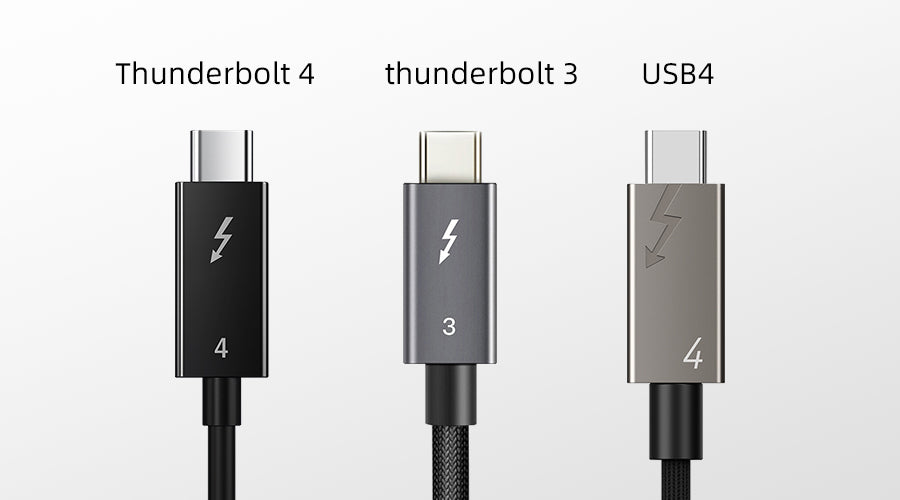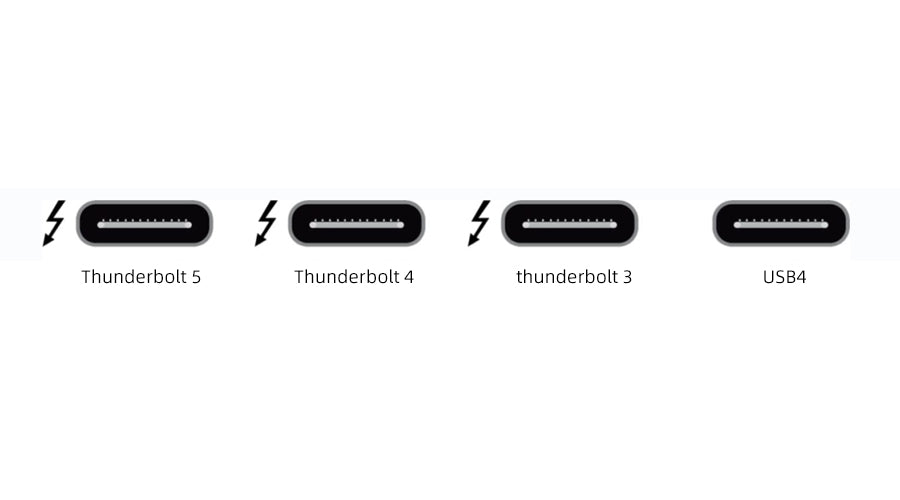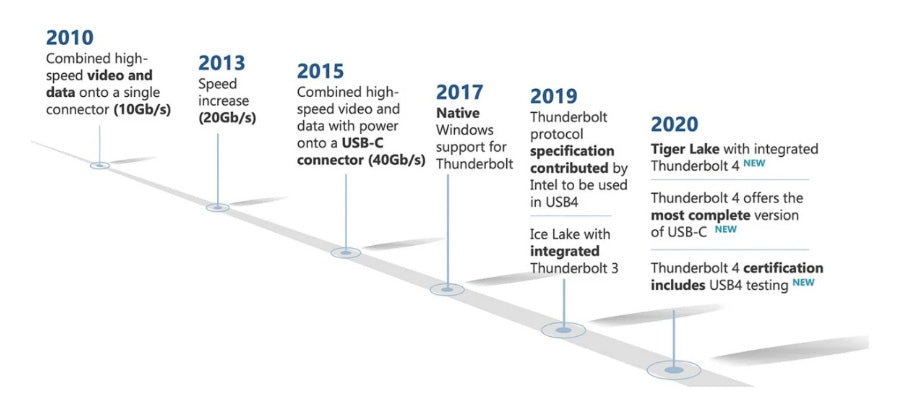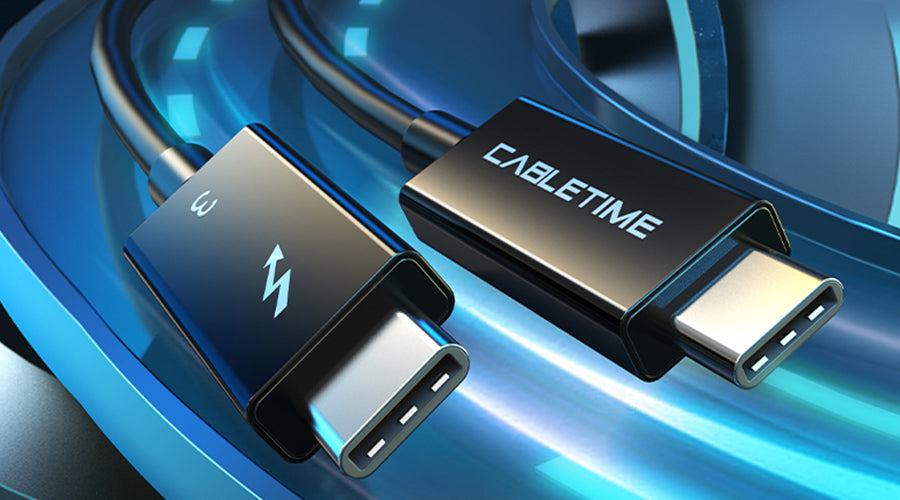What’s the Difference Between Thunderbolt 3, Thunderbolt 4, Thunderbolt 5, and USB4
Have you ever wondered what the differences are between the various versions of Thunderbolt and USB interfaces for high-speed data transfer? With Thunderbolt 3, Thunderbolt 4, Thunderbolt 5, and USB4 out there providing lightning-fast speeds, it can get confusing understanding the nuances across these specs. We'll clarify it all in this guide.


Key Takeaways
- Thunderbolt 3, 4, and 5 are industry-leading interface specifications for blazing fast transfers and high-resolution displays. USB4 aims to standardize and put USB-C on par with Thunderbolt speeds.
- While somewhat compatible, there are specific differences between the Thunderbolt generations and USB4 around transfer rates, charging power, cables, peripherals support, and mandatory device requirements that impact functionality.
- Each interface spec comes with distinctive pros and cons related to speed, versatility, cost, and compatibility that are important to consider for your specific needs.
Direct Comparison of Interface Parameters
Evolution History

Thunderbolt 3 was first introduced in 2015 to simultaneously support high-speed data transfers up to 40Gbps and power delivery up to 130W, while remaining compatible with legacy USB 3.1 accessories.
Thunderbolt 4 debuted in 2020 as an incremental update focused on more consistent mandatory requirements, including:
- Support for two 4K displays or one 8K display
- Wake from sleep access to peripherals
- 16 lanes of PCIe connectivity
The recently announced Thunderbolt 5 pushes things even further in 2023, touting:
- Blindingly quick 80Gbps transfer speeds
- Enhanced resource allocation for maximum performance
On a parallel track, USB4 essentially combines the best parts of Thunderbolt and traditional USB to simplify things. Formally released in 2019 after being in development for years, key aspects include:
- Leveraging the USB-C connector and Thunderbolt protocol
- Matching Thunderbolt 3's 40Gbps transmission capacity
So in summary - Thunderbolt revisions focus on pushing the boundaries of speed and capability, while USB4 offers a convergence of connectivity around the ubiquitous USB-C physical interface.
Comparison of Parameters
|
Spec |
Thunderbolt 3 |
Thunderbolt 4 |
Thunderbolt 5 |
USB4 |
|
Release Year |
2015 |
2020 |
2023 |
2019 |
|
Max Transfer Rate |
40Gbps |
40Gbps |
120 Gbps |
80Gbps, 40Gbps, 20Gbps, 10Gbps, and 5Gbps |
|
Max Power Delivery |
100W |
Required up to 100W Available up to 140W |
Required up to 140W Available up to 240W
|
240W |
|
PCIe Protocol Supported |
4 PCIe 3.0 lanes |
4 PCIe 3.0 lanes |
4 PCIe 4.0 lanes |
2 lanes |
|
Display Support |
2x 4K or 1x 8K at 60Hz |
Up to 2x 4K at 60Hz or 1x 8K |
3x 4K @144hz 2x6K |
Up to 2x 4K at 120Hz |
|
Cable Length |
0.5m Passive 2m Active |
8K@30Hz up to 2m Passive |
1 m (passive); 2 m active cable in development |
Up to 2m Passive |
|
Wake from Sleep for Peripherals |
Not Mandated |
Mandated |
TBD |
Not Mandated |
|
Compatibility |
Thunderbolt 1/2 devices |
Thunderbolt 1-3 devices |
Thunderbolt 1-4 devices |
Thunderbolt 3 & USB 3.2 devices
|
Are Thunderbolt 3, Thunderbolt 4, Thunderbolt 5, and USB4 Versions Compatible with Each Other?
The Thunderbolt interface generations have maintained backwards compatibility with previous versions to allow using older Thunderbolt peripherals. However, maximum speeds and capabilities align with the lowest common denominator.
For example, Thunderbolt 4 ports can connect to Thunderbolt 3 devices, but Thunderbolt 5 peripherals will not function as expected when plugged into a Thunderbolt 3 computer.
USB4 specifications can work with Thunderbolt 3 technologies too, seeing as USB4 essentially incorporates Thunderbolt 3 support. However, USB4 hosts and devices are compatible with Thunderbolt 1, 2 or 4 equipment. It’s called “backward compatibility”.
So there is interoperability to some degree across the interface specs, but observed performance depends on both ends of the connection complying with the fastest shared standard.
Advantages and Disadvantages of Thunderbolt 3

Introduction
First launched in 2015, Thunderbolt 3 represented a giant leap forward for peripheral connectivity and external display support. Let’s delve into the key benefits and drawbacks of this interface.
Advantages
- Blazing fast 40 Gbps bandwidth - With a 32 GB/s bidirectional transfer rate, Thunderbolt 3 enabled smooth 8K video editing and backing up massive files in a flash.
- Single compact port - The USB Type-C connector design allowed Thunderbolt 3 ports to deliver charging, video output, data transfers, and device networking through a single outlet on laptops and desktops.
- Daisy chaining peripherals - Up to 6 Thunderbolt devices could be interconnected in sequence opening up flexible usage configurations.
Disadvantages
- Expensive - Thunderbolt 3 cables and accessories generally cost more than traditional USB counterparts.
- Not universally available - Being mostly present only on higher end systems, Thunderbolt 3 ports were far from commonplace on cheaper consumer machines.
Scope of Application
Offering extremely high bandwidth perfect for applications like video production and rapid data duplication, Thunderbolt 3 excelled for creative professionals working with rich media. The specification was less relevant for typical everyday tasks where such extreme transfer speeds weren’t necessary.
How to Choose the Right Thunderbolt 3 Cable
With Thunderbolt 3 supporting various connectivity applications, Cabletime Tech offers active and passive models built for data or video workflows. Consider cable length for longer runs up to 20m, quality shielding for interference prone environments, and distinct performance targets when selecting your Thunderbolt 3 cord.
Advantages and Disadvantages of Thunderbolt 4

Introduction
In 2020, Thunderbolt 4 iterated on its widely successful predecessor Thunderbolt 3 by mandating more standardized functionality across certified devices. How does this latest offering improve the baseline experience?
Advantages
- Guaranteed peripheral compatibility - System wake from sleep now enables background access to any connected Thunderbolt accessories.
- More reliable performance - Stringent testing procedures ensure Thunderbolt 4 gear reliably sustains required bandwidth, reducing intermittent dropouts.
Disadvantages
- Constrained innovation - Defaulting to Intel CPUs with mandatory Intel controller integration limits vendor customizations and platform expansions for Thunderbolt 4.
Scope of Application
Thunderbolt 4 aims to drive adoption by enforcing cross-device consistency rather than focusing on bleeding edge speed improvements. This makes the updated interface most useful for creatives wanting assured compatibility across an ecosystem of Thunderbolt printers, storage drives, eGPU boxes, displays, and other specialized accessories.
How to Choose the Right Thunderbolt 4 Cable
While Thunderbolt 4 itself doesn’t radically transform speed or capability, longer and more resilient cabling remains crucial for architecting reliable signal communication between Thunderbolt machines and devices. For mission critical setups, Cabletime Tech’s premium shielded 40Gbps Thunderbolt 4 cords support fast pacing up to 20 meters without interference.
Advantages and Disadvantages of Thunderbolt 5
Introduction
Pushing the bleeding edge even further, Intel’s newly minted Thunderbolt 5 specification unlocks astonishing 80 Gbps channels for incredibly demanding production workflows. How else does this latest interface iteration leave its predecessors in the dust?
Advantages
- Double the throughput - With a blistering 80 Gbps maximum transfer rate, Thunderbolt 5 empowers 8K multi-cam video editing, rapid multi-terabyte project backups, and huge sample instrument sound library streaming previously unattainable over older Thunderbolt generations.
Disadvantages
- Cutting edge pricing - Early Thunderbolt 5 cables, SSD storage solutions, laptops, and workstations supporting the specification will certainly carry premium price tags only viable for lucrative commercial use cases.
Scope of Application
Geared foremost towards future-proofing for rising 8K production and post-production workflows, Thunderbolt 5 focused applications include game development, 3D animation and visual effects rendering, scientific visualization and analysis, broadcast video editing, and other massively intensive use cases most consumers don’t require.
Advantages and Disadvantages of USB4
Introduction
Riding on the coattails of Thunderbolt 3, USB4 aims to consolidate a fragmented ecosystem into one unified USB protocol matching Thunderbolt's cutting edge 40 Gbps transfer ceiling. How well does this ambitious initiative deliver the best of both worlds?
Advantages
- Ubiquitous USB-C connector - Tapping into existing USB Type-C ports, USB4 instantly works with the latest smartphones, tablets, and laptops without demanding Thunderbolt's less common port type.
- Cost efficiency - Piggybacking on established USB Type-C manufacturing, USB4 solutions sidestep Thunderbolt’s price premiums for more budget friendliness.
Disadvantages
- Optional capabilities - Unlike Thunderbolt's strictly enforced feature sets, inconsistent USB4 implementation allows makers to pick and choose what functionality to include leading to consumer confusion.
Scope of Application
USB4 blankets the masses by upgrading billions of existing USB-C devices with optional Thunderbolt-class 40Gbps headroom suited for slowly future-proofing mainstream market gadgets. But for mission critical applications, Thunderbolt still provides peak reliability.
How to Choose the Right USB4 Cable
As a baseline, USB4 cables must handle 20Gbps transfers to meet certification minimums. But for demanding 40Gbps speeds rivaling Thunderbolt 3, you'll want premium shielded USB4 cords, like these 2 meter options from Cabletime Tech, guaranteeing max throughput across extended runs.
Conclusion
We've covered the key nuances spanning Thunderbolt generations 3 through 5 plus USB4. While all raise the bar delivering lightning connectivity miles beyond outdated USB standards, notable tradeoffs exist around consistency vs cutting edge capability, specific workflow relevance, upfront and recurring costs, and future extensibility. Now you can better match interface specs against actual needs rather than just assume newer is universally better.
People Also Ask
Is USB4 the same as USB-C?
No, USB4 is not the same as USB-C. USB-C is a physical connector that can support various protocols, including USB4, Thunderbolt 3, and DisplayPort. USB4 is a data transfer protocol that offers faster speeds and improved features compared to previous USB standards.
What is the difference between Thunderbolt 3 and Thunderbolt 5?
Thunderbolt 5 is a newer version of Thunderbolt technology that offers higher bandwidth, display support, and charging capabilities compared to Thunderbolt 3. Thunderbolt 5 is expected to be available in 2024, while Thunderbolt 3 was introduced in 2015.
How much faster is Thunderbolt 4 than USB?
Thunderbolt 4 and USB4 offer the same maximum bandwidth of 40 Gbps. However, Thunderbolt 4 offers stricter certification requirements, improved power delivery, and support for dual 4K displays or a single 8K display, while USB4 is more of an evolutionary step from Thunderbolt 3.
Is USB4 the same as Thunderbolt 4?
No, USB4 is not the same as Thunderbolt 4. Thunderbolt 4 is based on Thunderbolt 3 technology and offers stricter certification requirements, improved power delivery, and support for dual 4K displays or a single 8K display. USB4 is a data transfer protocol that offers faster speeds and improved features compared to previous USB standards.
Can Thunderbolt 3 support 2 monitors?
Yes, Thunderbolt 3 can support up to two 4K displays or a single 5K display. However, the specific display configurations that are supported may vary depending on the device and the graphics card.
Can you connect Thunderbolt 4 to HDMI?
Yes, you can connect Thunderbolt 4 to HDMI using an HDMI adapter or cable. Thunderbolt 4 supports DisplayPort Alt Mode, which allows it to transmit video signals over a USB-C port. You can use an HDMI adapter or cable that supports DisplayPort Alt Mode to connect your Thunderbolt 4 device to an HDMI display.











